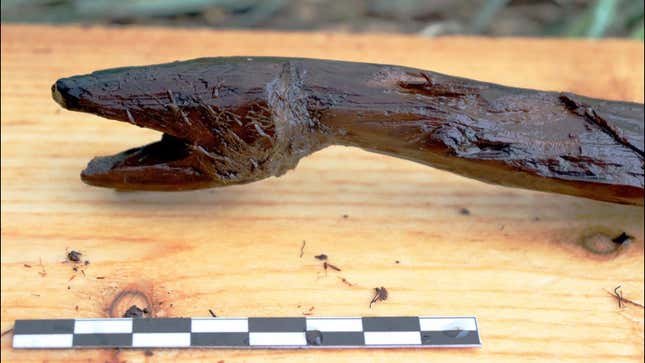
Archaeologists in Finland have uncovered a remarkable wooden snake figurine that possibly belonged to a Stone Age shaman.
The carved serpent was found at the Järvensuo 1 site in southwest Finland. A ditch-digging team accidentally stumbled upon this archaeological site back in the 1950s, but it hadn’t been fully excavated. Excavations at Järvensuo 1 resumed in 2019 for the first time in 35 years.
Previous digs at Järvensuo 1 yielded fishing tools and pottery, along with a unique wooden scoop with a handle carved in the shape of a bear’s head. The site was occupied by Stone Age peoples from between 4,000 and 2,000 BCE. Sedimentation and soggy conditions at this wetlands site—a former lakeshore—have allowed for the long-term preservation of artifacts, particularly items made from wood.

The carved wooden snake figurine was found at a depth of nearly 2 feet (0.6 meters), and it made quite an impression on the archaeologists who discovered it.
“I have seen many extraordinary things in my work as a wetland archaeologist, but the discovery of this figurine made me utterly speechless and gave me the shivers,” Satu Koivisto, the lead author of the study and an archaeologist at the University of Turku, said in an emailed statement.

Carved from a single piece of wood, the snake figurine measures 21 inches (53 cm) long and roughly 1.1 inches (2.8 cm) thick. The head is portrayed in a slightly raised position and with an open mouth. The carving appears to resemble a snake in the act of slithering or swimming away. Indeed, it’s very realistic and reminiscent of a grass snake (Natrix natrix) or a European adder (Vipera berus), according to the study. Radiocarbon dating produced an age of 4,400 years, placing it in the Neolithic period. Details of this discovery were published in the science journal Antiquity.
“The figurine was lying on its right side, either having been lost, discarded or intentionally deposited amidst the thick lakeshore vegetation,” wrote the scientists in the study. The carving is unique in both “style and character,” they wrote, as no other artifacts dating back to this period in northern Europe can compare.

It’s tough to gauge the significance or purpose of the artifact, as the nature of the site is not yet fully understood. But the researchers theorize that it’s a Stone Age shaman’s staff, as they write in the study:
It is unclear if the figurine was a freestanding sculpture or a staff (or both), and either way a multitude of interpretations is possible. As a preliminary hypothesis, it seems reasonable, however, to place the artefact in the religious sphere. Snakes are loaded with symbolic meaning in both Finno-Ugric and Sámi cosmology, and shamans were believed to be able to transform into snakes. Moreover, the Land of the Dead was believed to lie under water, which seems interesting given the wetland setting of the Järvensuo figurine.
What’s more, rock art dating back to the same time and place depicts human figures holding snake-like objects. It therefore makes sense to link the wooden snake to the northern shamanism of the time, during which snakes played an important role as spirit-helper animals.
Snakes played an important role in other Stone Age cultures, too. Back in 2019, archaeologists reported on the discovery of preserved, 1,500-year-old human poop containing the remnants of an entire snake—fang included. The scientists theorized that the snake was consumed for ritualistic purposes rather than nutrition.